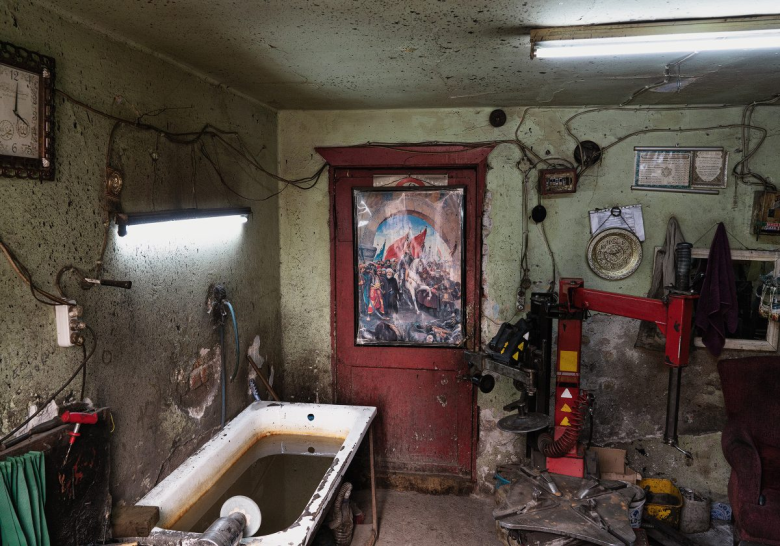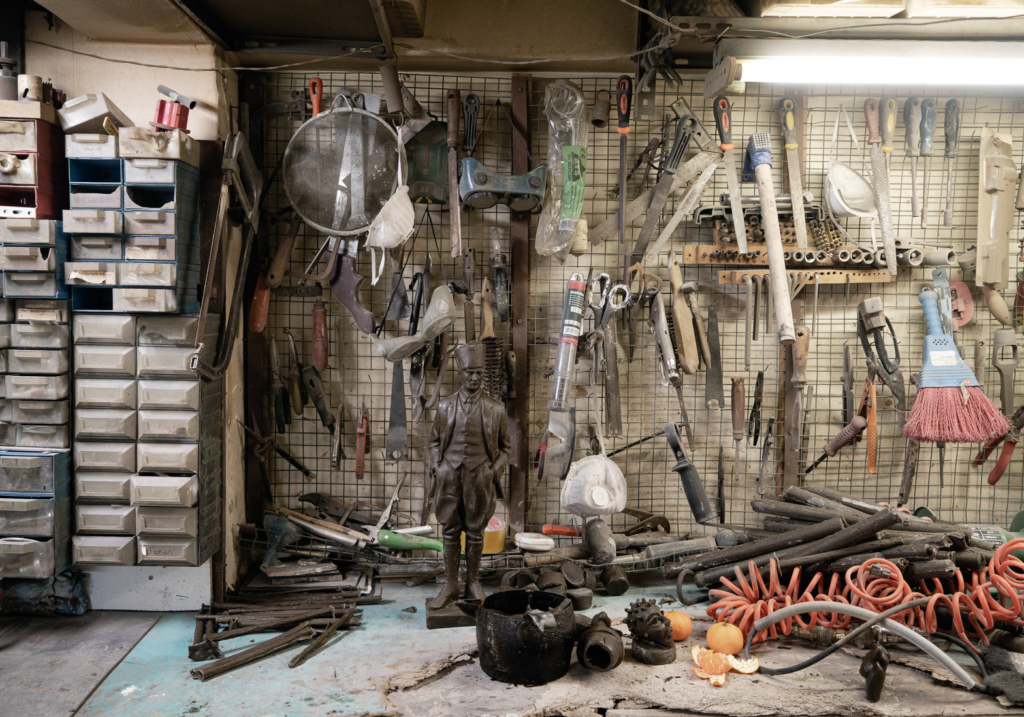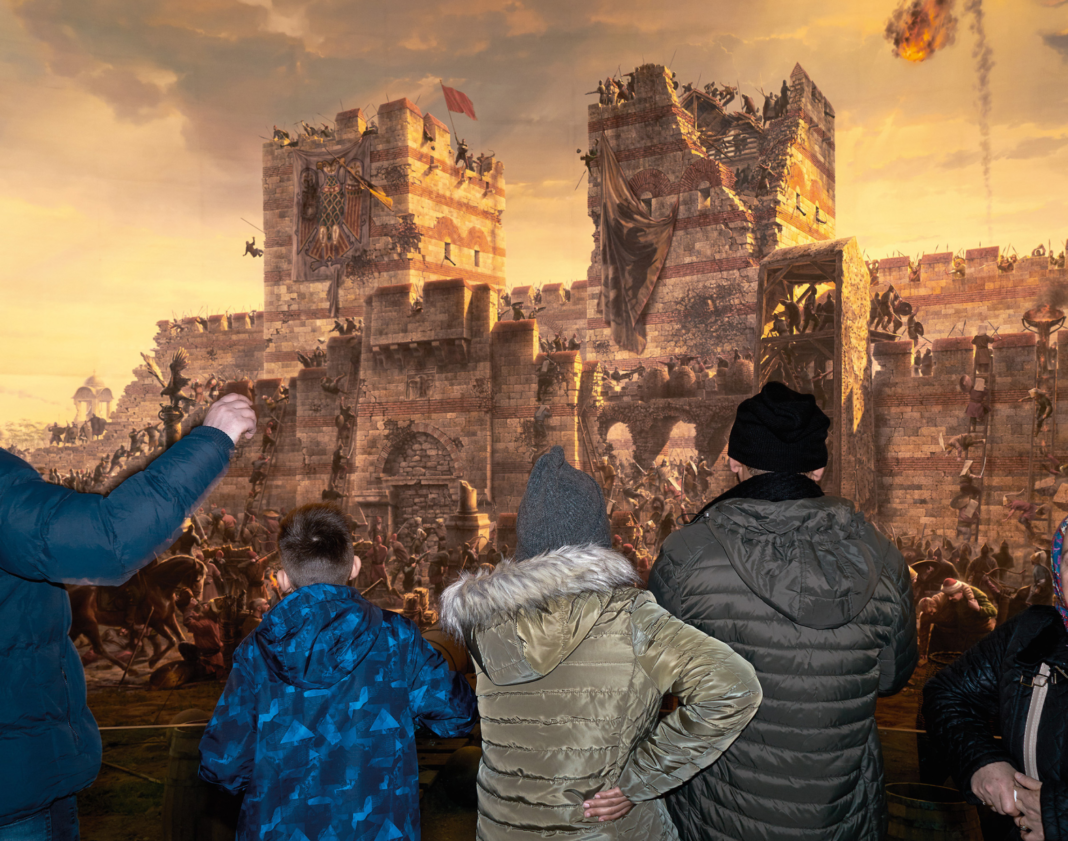Jennifer Hattam shares her perspective on Andréas Lang’s photographic body of work, featured in the newly released book ‘Broken Memories.’ These captivating images were showcased following his exhibition at the Istanbul cultural center Depo in June, as discussed in her article on Hyperallergic. Andréas Lang’s pictures convey “what the Turkish state wants people to remember and what it wants them to forget.”
ISTANBUL — In Andréas Lang’s photographs, what’s missing is often as important as what’s actually captured within the frame. A cave-studded rock formation looming over an empty road on the outskirts of the Turkish capital city of Ankara in his 2022 landscape image “Stanoz, Turkey,” for example, marks the site of an eponymous village populated for centuries by Armenians until the 1915 genocide. Today, all that is left of old Stanoz are a few gravestones.
In previous projects, the Berlin-based artist used this approach, which he defines as “visual archaeology,” to explore the lingering reverberations of the medieval Crusades and 19th-century German colonialism. His photographic excavations in Turkey were recently published in the book Broken Memories (Kerber Verlag, July 2023), which combines Lang’s pictures of places bearing the traces of the Armenian communities that once thrived in Anatolia (modern-day Turkey) with those of sites where newer historical narratives are still being constructed and reinforced.
“As an Armenian born and raised in Turkey, I didn’t even know about many of the places in Andréas’s photographs,” academic Aylin Vartanyan, who wrote a text for the Broken Memories book, said at a talk held at the Istanbul cultural center Depo in June. “At first I was ashamed of myself,” she said, adding that she subsequently began to reflect on how these stories had been actively rendered invisible.

“The images speak to what the Turkish state wants people to remember, and what it wants them to forget,” said Asena Günal, program coordinator at Depo, which hosted a solo exhibition of Lang’s work, also titled Broken Memories, from April 18 to July 14. Depo is a project of Anadolu Kültür, a nonprofit cultural institution founded by businessman-philanthropist Osman Kavala, who is serving a life sentence in prison along with other civil-society figures associated with the organization. The show was curated by Serdar Darendeliler and Refik Akyüz from the photography-focused Wide Angle Project Office (GAPO).
The creation of national narratives and the denial in which they are often based is something that intrigues Lang. “Being from a German background, I see parallels,” he said, adding that Germany’s role as an ally to the Ottoman Empire during World War I also contributed to his interest in the tragic history of eastern Anatolia.
Lang’s travels in Turkey took him from the country’s eastern border, where the crumbling churches at Ani attest to its past as the stronghold of a medieval Armenian kingdom; to Istanbul, where he photographed the city center steps leading to Gezi Park, built on a spot that was once an Armenian cemetery (“Taksim,” 2018); and to the rugged southern peak of Musa Dağ, where a few thousand Armenians staged a successful resistance in 1915. An estimated 1.5 million Armenians were massacred that year by Ottoman forces, an event that Turkey refuses to recognize as a genocide. Today, the country’s Armenian population has dwindled to fewer than 70,000 people.
“What I found striking was the complete absence of any information, any story, especially in the eastern and southeastern regions, about the people who lived there before the genocide,” Lang told Hyperallergic. “Even in Ani, which was a very important Armenian capital, that history is quite obscured by the narrative about Alp Arslan, the Seljuk sultan who captured the city in 1064.”

To find some of the spots he photographed, Lang had to follow historical hints in sources that ranged from accounts by soldiers who witnessed the Armenian genocide to mentions in novels, poems, conversations, and blog posts by Armenian travelers. He also drew on the work of the Hrant Dink Foundation, named after the assassinated Armenian-Turkish journalist, which has created an extensive inventory of cultural heritage sites associated with Turkey’s minority populations.
Vartanyan said she was particularly struck by a pair of Lang’s images that depict two interior scenes in Istanbul. In one, “Ottoman Mechanic” (2018), a poster of Mehmet II, the Ottoman sultan who conquered Constantinople, hangs on the wall of a tire repair shop. The other, “Atatürk Republic Repair” (2018), shows a sculpture of Mustafa Kemal Atatürk, the founder of the modern Turkish Republic, standing in the metal workshop where the statue was crafted.
“These two photographs appeared to me as laboratories; if there were places where collective memory was built, maybe they would look something like this, places where there is only room for stories of victories, not those of pain,” Vartanyan said.

These types of images, including photographs of history museums, film sets, battlefield dioramas, and monumental sculptures, form what Darendeliler described as the second axis in Lang’s body of work. “One axis is more about the Armenian heritage and the late Ottoman/early Republican era; the rest is about the reconstruction of history according to the ideologies of the current times,” he told Hyperallergic. “The two axes come together through the texts to reveal their interconnections.”

Darendeliler pointed to an image of a ruined Armenian house of worship (“St. Sarkis Church,” 2021), as resonant not only of the southeastern city of Diyarbakır’s lost Armenian population, but of more recent violence in early 2016 that reduced large parts of its historic center to rubble. The post-conflict reconstruction in Diyarbakır’s Sur neighborhood has been criticized for displacing predominantly poor and Kurdish residents and creating a sanitized theme-park version of the past — as has happened in Hasankeyf, an ancient town that Lang photographed after its monuments were relocated to a new “archaeopark.” And many fear a similar fate may befall Antakya, a multicultural city that was nearly leveled in this year’s devastating earthquakes.
Questioning the dominant narratives can be dangerous, however. Historians, authors, human rights activists, and ordinary citizens in Turkey have been investigated, prosecuted, or arrested for “insulting the memory of Atatürk,” a crime under Turkish law; while journalists and TV directors have been threatened with legal action for purportedly mocking or misrepresenting the Ottoman sultans. Statements related to the Armenian genocide are among those that have been deemed objectionable.
“The second indictment against Osman Kavala included a part about the work we as Anadolu Kültür have done on Armenian issues, which were painted as ‘acts to divide the country,’” Günal told Hyperallergic. “This shows that deep down the state is not happy about activities done to contribute to public memory.”
Amid the jailing of its founder and the ongoing threats to the existence of the space, Turkey’s Trade Ministry has sued to shut down Anadolu Kültür’s operations entirely. Lang’s Broken Memories was only the latest of numerous shows since the venue’s founding in 2008 in which artists have grappled with sensitive topics, often related to minority groups in Turkey. Though art linked to LGBTQ+ issues is currently most likely to be targeted by conservative factions in society, Günal said that a recent controversy over the next curator of the Istanbul Biennial shows that “there is still a lot of denial” about the Armenian genocide.
That denial has created what Vartanyan, drawing on intergenerational trauma studies, has described as a “chronic pain” running through the entire geography of Turkey. “A collective memory that is rendered invisible turns into chronic pain,” she said at the exhibition talk at Depo. “Andreas’s photos illuminate these ruptures that we need to confront in order to ease our souls.”

Jennifer Hattam, September 18, 2023, Hyperallergic

